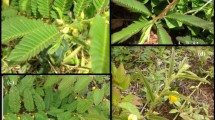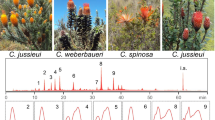Abstract
Origanum × majoricum Cambess. is the most commonly grown oregano in Argentina. The aim of this work was to explore and describe its polyphenolic profile by high-performance liquid chromatography with diode array detection (HPLC-DAD) to support identification by classical microscopy. Remarkable homogeneity was found when defining the HPLC-DAD fingerprint with 17 characteristic common peaks. Eleven spectroscopically identified compounds were located. The method was successfully applied for the characterization of 22 samples from different productive regions of Argentina. The genetic inheritance from both progenitors of this hybrid oregano was evidenced by the presence of compounds coming from Origanum majorana L. and Origanum vulgare L. This method, combined with statistical multivariate analysis, was also useful to recognize two groups within the samples. Although O. × majoricum Cambess. must be considered the only hybrid between two species, two origins considering the subspecies level of O. vulgare L. have been morphologically differentiated for the hybrid, both with O. majorana L. These formulas were differentiated by their HPLC-DAD fingerprints. The Argentine hybrids studied appeared consistently grouped under these two profiles.



Similar content being viewed by others
References
Argüello JA, Núñez SB, Davidenco V, Suárez DA, Seisdedos L, Baigorria MC, La Porta N, Ruiz G, Yossen V (2012) Sistema de producción y cadena de valor del cultivo de Orégano (Origanum sp.) en la Provincia de Córdoba (Argentina). Φhyton (Buenos Aires) 81:23–34
Azizi A, Wagner C, Honermeier B, Friedt W (2009) Intraspecific diversity and relationships among subspecies of Origanum vulgare L. revealed by comparative AFLP and SAMPL marker analysis. Plant System and Evol 281:151–160
D’Antuono FL, Galletti GC, Bocchini P (2000) Variability of essential oil content and composition of Origanum vulgare L. populations from a North Mediterranean area (Liguria region, northern Italy). Ann Bot 86(3):471–478. doi:10.1006/anbo.2000.1205
Dambolena JS, Zunino MP, Lucini E, Olmedo R, Banchio E, Bima PJ, Zygadlo JA (2010) Total phenolic content, radical scavenging properties, and essential oil composition of Origanum species from different populations. J Agric Food Chem 58:1115–1120. doi:10.1021/jf903203n
Davidenco V, Vega C, Argüello JA (2012) Photoperiodic response in Origanum vulgare ssp. vulgare and ssp. hirtum Ietsw: impact on development and growth rev.Fca. UNCUYO 44:1-12 ISSN press 0370-4661 ISSN on line 4853-8665
Farias G, Brutti O, Grau R, Di Leo LP, Retta D, van Baren C, Vento S, Bandoni AL (2010) Morphological, yielding and quality descriptors of four clones of Origanum spp. (Lamiaceae) from Argentina littoral region Germoplasm bank. Ind. Crops and Prod 32:472–480. doi:10.1016/j.indcrop.2010.06.019
González MD, Luis CM, Lanzelotti PL (2014) Polyphenolic profile of Origanum vulgare l.ssp.viridulum from Argentina. Фhyton (Buenos Aires) 83:179–184 ISSN 0031 9457
González MD, Lanzelotti PL, Luis CM (2017) Chemical fingerprinting by HPLC-DAD to differentiate certain subspecies of origanum vulgare L. Food Anal Methods 10:1460–1468. doi:10.1007/s12161-016-0704-2
Grevsen K, Fretté XC, Christensen LP (2009) Content and composition of volatile terpenes, flavonoids and phenolic acids in Greek oregano (Origanum vulgare L. Ssp. hirtum) at different development stages during cultivation in cool temperate climate. Europ J of Hortic Sci 74:193–203 ISSN 1611-4426
Hong JH, Tomas-Barberan FA, Kader AA, Mitchell AE (2006) The flavonoid glycosides and procyanidin composition of deglet noor dates. J Agric Food Chem 54(6):2405–2411
Husain SZ, Markham KR (1981) The glycoflavone vicenin-2 and its distribution in related genera within the Labiatae. Phytochemistry 20:1171–1173
Ibrahim SK, Ibrahim L, Ismail A, Basal A, Kayal M, Ghanem H, Rammel S (2011) Differentiation of different species of Origanum and Thymus using proteins and isoenzymes profile. Int J of Botany 7:283–288. doi:10.3923/ijb.2011.283.288
Ietswaart JH (1980) A taxonomic revision of the genus Origanum (Labiatae). Leiden University, The Hague
International Code of Nomenclature for Algae, Fungi and Plants, Melbourne (2012). IAPT (International Association for Plant Taxonomy). Available at http://www.iapt-taxon.org/nomen/main.php. Acceded 17.03.16
Kang MJ, Ha HW, Kim HG, Lee DH, Kong MJ, Kim DH, Shin BS, Kang W, Jeong HG, Ahn YT, Jeong TC (2011) Role of metabolism by intestinal bacteria in arbutin-induced toxicity in vitro. Archives of Pharmacological Research 34:687–693
Katsiotis A, Nikoloudakis N, Linos A, Drossou A, Constantinidis T (2009) Phylogenetic relationships in Origanum spp. based on rDNA sequences and intra-genetic variation of Greek O. vulgare subsp. hirtum revealed by RAPD. Sci Hortic 121:103–108
Koukoulitsa C, Karioti A, Bergonzi CM, Pescitelli G, Di Bari L, Skaltsa H (2006) Polar constituents from the aerial parts of Origanum vulgare L. ssp. hirtum growing wild in Greece. J Agric Food Chem 54:5388–5392. doi:10.1021/jf061477i
Lianga Y-Z, Xieb P, Chanc K (2004) Quality control of herbal medicines. J of chromatography B 812:53–70. doi:10.1016/j.jchromb.2004.08.041
Lukas B, Schmiderer C, Mitteregger U, Novak J (2010) Arbutin in marjoram and oregano. Food Chem 121:185–190
Lukas B, Schmiderer C, Novak J (2013) Phytochemical diversity of Origanum vulgare L. ssp. vulgare (Lamiaceae) from Austria. Bioch Sys Ecol 50:106–113. doi:10.1016/j.bse.2013.03.037
Mabry T, Markham KR, Thomas MB (1970) The systematic identification of flavonoids. Springer-Verlag, Berlin
Marieschi M, Torelli A, Bianchi A, Bruni R (2011) Detecting Satureja montana L. and Origanum majorana L. by means of SCAR-PCR in commercial samples of Mediterranean oregano. Food Control 22:542–548
Martins N, Barros L, Santos-Buelga C, Henriques M, Silva S, Ferreira IC (2014) Decoction, infusion and hydroalcoholic extract of Origanum vulgare L.: different performances regarding bioactivity and phenolic compounds. Food Chem 158:73–80
Matsuura H, Chiji H, Asakawa C, Amano M, Yoshihara T, Mizutani J (2003) DPPH radical scavengers from dried leaves of oregano (Origanum vulgare). Biosci Biotechnol Biochem 67:2311–2316. doi:10.1271/bbb.67.2311
Nakatani N, Kikuzaki H (1987) A new antioxidative glucoside isolated from oregano (Origanum vulgare L) Agric. Biol Chem 51(2727–273):1. doi:10.1080/00021369.1987.10868446
Novak J, Lukas B, Bolzer K, Grausgruber-Gröger S, Degenhardt J (2007) Identification and characterization of simple sequence repeat markers from a glandular Origanum vulgare expressed sequence tag. Molec Ecol Resources 8:599–601
Petersen M, Simmonds MS (2003) Rosmarinic acid. Phytochemistry 62:121–125
Quiroga PR, Riveros CG, Zygadlo JA, Grosso NR, Nepote V (2011) Antioxidant activity of essential oil of oregano species from Argentina in relation to their chemical composition. Int J Food Sci & Tech 46:2648–2655
Rolando A, González MD (2005) Chemical study on a water extract of Argentine commercial origanum. J of the Argen Chem Soc 93:225–231
Rouquaud E, Videla ME (2000) Oréganos de Mendoza (Argentina). Rev Fac UNCuyo 32:23–32
Seibl J, Simon W, Pretsch E, Clerc T (1998) Tablas para la determinación estructural por métodos espectroscópicos. Updated translation from the German, 3rd edn. Springer-Verlag, Iberica Ed
Torres LE, Chaves AG, Barboza G, Brunetti PC, Bustos JA, Massuh Y, Ocaño SF, Castillo N, Ojeda MS (2010) Evaluation of the agronomic performance and taxonomic characterization of four clones of oregano (Origanum sp.) Molecular Medicinal Chemistry 21:91–94 ISSN 1666-888X
Torres LE, Brunetti PC, Baggio C, Bauzá PG, Chaves AG, Massuh Y, Ocaño SF, Ojeda MS (2012) Field evaluation of twelve clones of oregano grown in the main production areas of Argentina: identification of quantitative trait with the highest discriminant value. ISRN Agronomy, 2012, Article ID 349565, 10 pages, 2012. doi:10.5402/2012/349565
Viturro CI, Molina AC, Villa WC, Heit CI (2010) Characterization of Origanum species grown in Quebrada de Humahuaca, Jujuy, Argentina, through the study of the essential oils. Molecular Medicinal Chemistry 21:73–79
Vokou D, Kokkini S, Bessiere J-M (1993) Geographic variation of Greek oregano (Origanum vulgare ssp. hirtum) essential oils. Biochem Syst and Ecol 21:287–295. doi:10.1016/03051978(93)90047-U
Xifreda CC (1983) Sobre oréganos cultivados en la Argentina. Kurtziana 16:133–148
Zhang X-L, Guo Y-S, Wang C-H, Li G-Q, Xu J-J, Chung HY, Ye W-C, Li Y-L, Wang G-C (2014) Phenolic compounds from Origanum vulgare and their antioxidant and antiviral activities. Food Chem 152:300–306
Acknowledgements
This work has been financially supported by the Departamento de Ciencias Básicas of the Universidad Nacional de Luján (Disp No. 427/09). The authors thank Eng. Agr. Otto Brutti, Eng. Agr. Pablo Bauzá, and Dr. Lorena Torres for providing samples of O. × majoricum Cambess. We thank Eng. Agr. Cecilia Xifreda for the pieces of advice and the revision of micrographic observations. We also thank Laboratorio de Control de Calidad Melacrom S.C. for performing the HPLC-DAD chromatograms.
Author information
Authors and Affiliations
Corresponding author
Ethics declarations
Conflict of Interest
M. D. González declares that she has no conflict of interest. P. L. Lanzelotti declares that she has no conflict of interest. C. M. Luis declares that she has no conflict of interest.
Ethical Approval
This article does not contain any studies with human participants or animals performed by any of the authors.
Informed Consent
Not applicable
Rights and permissions
About this article
Cite this article
González, M.D., Lanzelotti, P.L. & Luis, C.M. Characterization of the Polyphenolic Fingerprint of Origanum × majoricum Cambess. From Argentina by High-Performance Liquid Chromatography and Multivariate Analysis. Food Anal. Methods 10, 3275–3284 (2017). https://doi.org/10.1007/s12161-017-0894-2
Received:
Accepted:
Published:
Issue Date:
DOI: https://doi.org/10.1007/s12161-017-0894-2




